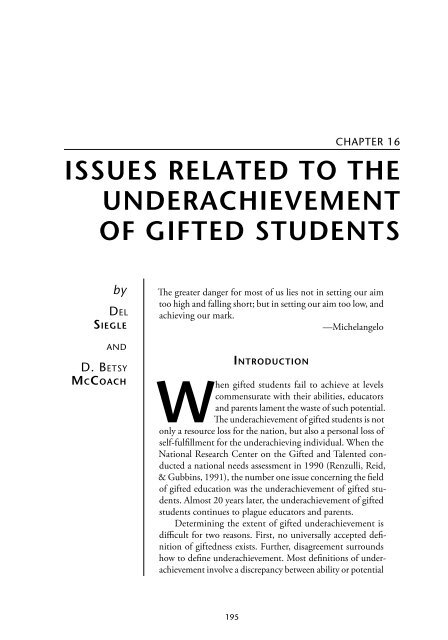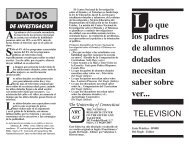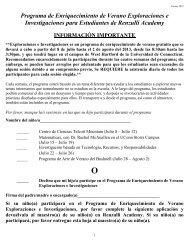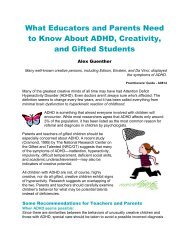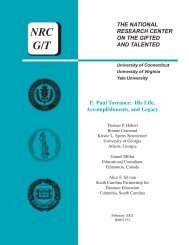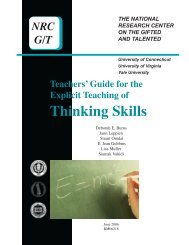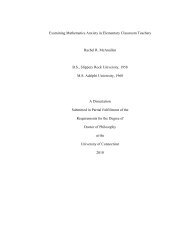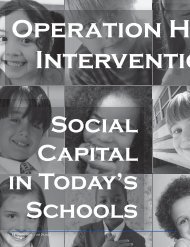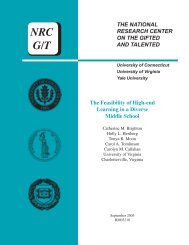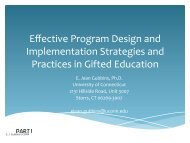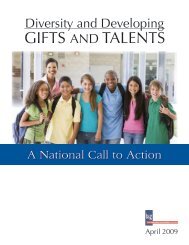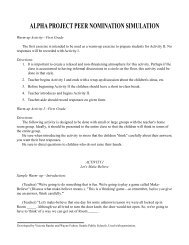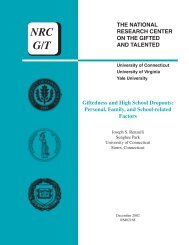issues related to the underachievement of gifted students
issues related to the underachievement of gifted students
issues related to the underachievement of gifted students
Create successful ePaper yourself
Turn your PDF publications into a flip-book with our unique Google optimized e-Paper software.
Chapter 16Issues Related <strong>to</strong> <strong>the</strong>Underachievemen<strong>to</strong>f Gifted StudentsbyDelSie g l ea n dD. Be t s yMcCoa c hThe greater danger for most <strong>of</strong> us lies not in setting our aim<strong>to</strong>o high and falling short; but in setting our aim <strong>to</strong>o low, andachieving our mark.—MichelangeloInt r o d u c t i o nWhen <strong>gifted</strong> <strong>students</strong> fail <strong>to</strong> achieve at levelscommensurate with <strong>the</strong>ir abilities, educa<strong>to</strong>rsand parents lament <strong>the</strong> waste <strong>of</strong> such potential.The <strong>underachievement</strong> <strong>of</strong> <strong>gifted</strong> <strong>students</strong> is no<strong>to</strong>nly a resource loss for <strong>the</strong> nation, but also a personal loss <strong>of</strong>self-fulfillment for <strong>the</strong> underachieving individual. When <strong>the</strong>National Research Center on <strong>the</strong> Gifted and Talented conducteda national needs assessment in 1990 (Renzulli, Reid,& Gubbins, 1991), <strong>the</strong> number one issue concerning <strong>the</strong> field<strong>of</strong> <strong>gifted</strong> education was <strong>the</strong> <strong>underachievement</strong> <strong>of</strong> <strong>gifted</strong> <strong>students</strong>.Almost 20 years later, <strong>the</strong> <strong>underachievement</strong> <strong>of</strong> <strong>gifted</strong><strong>students</strong> continues <strong>to</strong> plague educa<strong>to</strong>rs and parents.Determining <strong>the</strong> extent <strong>of</strong> <strong>gifted</strong> <strong>underachievement</strong> isdifficult for two reasons. First, no universally accepted definition<strong>of</strong> <strong>gifted</strong>ness exists. Fur<strong>the</strong>r, disagreement surroundshow <strong>to</strong> define <strong>underachievement</strong>. Most definitions <strong>of</strong> <strong>underachievement</strong>involve a discrepancy between ability or potential195
196 Sie g l e an d McCoa c h(expected performance) and achievement (actual performances; Baum, Renzulli, &Hébert, 1995a; Dowdall & Colangelo, 1982; Emerick, 1992; Reis & McCoach,2000; Rimm, 1997; Supplee, 1990; Whitmore, 1980). However, researchers andscholars differ in terms <strong>of</strong> how <strong>the</strong>y operationalize <strong>the</strong> discrepancy between potentialand performance. For instance, Emerick (1988) suggested this discrepancy mightinclude any <strong>of</strong> <strong>the</strong> following combinations: high IQ score and low achievement testscores; high IQ score and low grades; high achievement test scores and low grades;high indica<strong>to</strong>rs <strong>of</strong> intellectual, creative potential and low creative productivity; orhigh indica<strong>to</strong>rs <strong>of</strong> potential and limited presence <strong>of</strong> appropriate opportunity forintellectual and creative development. However, <strong>the</strong> subpopulations <strong>of</strong> <strong>students</strong>identified using <strong>the</strong>se different discrepancy definitions are likely <strong>to</strong> be radicallydifferent. This example helps <strong>to</strong> illustrate <strong>the</strong> difficulties surrounding <strong>the</strong> multipledefinitions and operationalizations <strong>of</strong> <strong>gifted</strong>ness and <strong>underachievement</strong>.Reis and McCoach published an extensive review <strong>of</strong> literature on <strong>gifted</strong>underachievers in 2000. In that review, <strong>the</strong>y proposed an operational definition<strong>of</strong> <strong>underachievement</strong> that has been adopted in several empirical studies (Mat<strong>the</strong>ws& McBee, 2007; McCoach & Siegle, 2003; Siegle, Reis, & McCoach, 2006). Theyposited that:Underachievers are <strong>students</strong> who exhibit a severe discrepancy betweenexpected achievement (as measured by standardized achievement test scoresor cognitive or intellectual ability assessments) and actual achievement(as measured by class grades and teacher evaluations). To be classified asan underachiever, <strong>the</strong> discrepancy between expected and actual achievementmust not be <strong>the</strong> direct result <strong>of</strong> a diagnosed learning disability andmust persist over an extended period <strong>of</strong> time. Gifted underachieversare underachievers who exhibit superior scores on measures <strong>of</strong> expectedachievement (i.e., standardized achievement test scores or cognitive orintellectual ability assessments). (Reis & McCoach, 2000, p. 157)The severity <strong>of</strong> <strong>the</strong> discrepancy required <strong>to</strong> label someone as a <strong>gifted</strong> underachieveralso is a crucial component <strong>of</strong> any operationalization <strong>of</strong> <strong>the</strong> construct.Given <strong>the</strong> phenomenon <strong>of</strong> regression <strong>to</strong> <strong>the</strong> mean, we would not expect <strong>the</strong> achievementlevels <strong>of</strong> those with <strong>the</strong> highest measured ability <strong>to</strong> be equally extreme. Inaddition, most people probably perform somewhat below <strong>the</strong>ir capacity or ability.Thus, <strong>the</strong> discrepancy between a student’s ability and his or her achievement mustbe severe enough <strong>to</strong> warrant substantial concern. Operationalizing this degree <strong>of</strong>discrepancy is critical for research on <strong>gifted</strong> underachievers.Although grades are less reliable than standardized measures <strong>of</strong> academicachievement, <strong>the</strong>y do provide an indication <strong>of</strong> a student’s current level <strong>of</strong> achievementwithin a classroom environment. In addition, <strong>to</strong> some extent, grades alsoreflect student motivation. Conversely, <strong>students</strong> with high ability and low standardizedachievement test scores may be underachievers, or <strong>the</strong>y may have undiagnosedlearning disabilities. Therefore, Moon and Hall (1998) recommended that <strong>gifted</strong>Lea d i n g Ch a n g e in Gi f t e d Ed u c a t i o n :
Gif t e d Un d e r a c h i e v e r s197<strong>students</strong> with low standardized achievement test scores should be screened forundiagnosed learning disabilities prior <strong>to</strong> treating <strong>the</strong>m as underachievers.Without a commonly accepted definition <strong>of</strong> <strong>gifted</strong>ness or a common definition<strong>of</strong> <strong>underachievement</strong>, it is impossible <strong>to</strong> determine how prevalent <strong>underachievement</strong>is among <strong>gifted</strong> <strong>students</strong>. Speculation ranges from 10% <strong>to</strong> more than 50%(H<strong>of</strong>fman, Wasson, & Christianson, 1985; Richert, 1991). The issue is fur<strong>the</strong>rconfused when considering <strong>underachievement</strong> in academics versus <strong>underachievement</strong>in nonacademic areas, which <strong>of</strong>ten are essential for original contributions<strong>to</strong> a field (Richert, 1991). Therefore, as McCoach and Siegle (2008) noted, anyestimation <strong>of</strong> <strong>the</strong> number <strong>of</strong> <strong>gifted</strong> underachievers is speculation at best.When parents and teachers are asked <strong>to</strong> identify underachievers, <strong>the</strong>y predominatelyidentify males. Across a number <strong>of</strong> studies <strong>of</strong> underachievers, <strong>the</strong> ratio <strong>of</strong>male underachievers <strong>to</strong> female underachievers appears <strong>to</strong> be at least 2:1 (Baker,Bridger, & Evans, 1998; Mat<strong>the</strong>ws & McBee, 2007; McCoach, 2002; Peterson& Colangelo, 1996; Richert, 1991; Siegle, Reis, McCoach, Mann, et al., 2006).However, Richert suggested that although twice as many males as females underachieveacademically in school, “over an individual’s lifetime, females as a groupare <strong>the</strong> greater underachievers” (p. 145). This is because women are far more likely<strong>to</strong> abandon or compromise <strong>the</strong>ir careers <strong>to</strong> take care <strong>of</strong> family obligations suchas children.Empirical Li t e r at u r eUnderachievement tends <strong>to</strong> appear in middle school and <strong>of</strong>ten continues in<strong>to</strong>high school (Peterson & Colangelo, 1996). Peterson and Colangelo examined <strong>the</strong>school records <strong>of</strong> 153 <strong>gifted</strong> <strong>students</strong> and analyzed trends in <strong>the</strong>ir achievementthroughout <strong>the</strong>ir secondary school careers. In <strong>the</strong>ir study, 45% <strong>of</strong> <strong>the</strong> <strong>students</strong>who were underachieving in grade 7 continued <strong>to</strong> underachieve throughout juniorhigh and high school. Peterson (2000) later conducted a follow-up study <strong>of</strong> <strong>the</strong>seachievers and underachievers 4 years after high school graduation. High school andcollege academic achievement were strongly <strong>related</strong> (r = .64). All <strong>of</strong> <strong>the</strong> achieversin her study attended college, and 83% <strong>of</strong> <strong>the</strong> achievers finished 4 years <strong>of</strong> college.In contrast, 87% <strong>of</strong> underachievers attended college; only 52% finished 4 years.In <strong>the</strong> largest longitudinal study <strong>of</strong> underachievers conducted <strong>to</strong> date, McCall,Evahn, and Kratzer (1992) found that 13 years after high school, <strong>the</strong> educationaland occupational status <strong>of</strong> high school underachievers paralleled <strong>the</strong>ir grades inhigh school, ra<strong>the</strong>r than <strong>the</strong>ir abilities. They also found that underachievers wereless likely <strong>to</strong> complete college and remain in <strong>the</strong>ir jobs.Underachievement can occur when <strong>gifted</strong> <strong>students</strong> do not receive <strong>the</strong> supportand educational services <strong>the</strong>y require <strong>to</strong> develop <strong>the</strong>ir talent. Gifted <strong>students</strong> <strong>of</strong>poverty and <strong>students</strong> from underserved groups are particularly vulnerable. Studentswho are not given adequate opportunities <strong>to</strong> develop <strong>the</strong>ir talents <strong>of</strong>tenbecome “involuntary underachievers.” Forty-four percent <strong>of</strong> lower income <strong>students</strong>The Fe s t s c h r i f t <strong>of</strong> Dr. Jo y c e Va nTas s e l-Ba s k a
198 Sie g l e an d McCoa c hwho enter first grade in <strong>the</strong> <strong>to</strong>p 10% will not score in <strong>the</strong> <strong>to</strong>p 10% by <strong>the</strong> time<strong>the</strong>y reach fifth grade (Wyner, Bridgeland, & DiIulio, 2007). Gifted <strong>students</strong>from higher income homes progress twice as fast as <strong>the</strong>ir <strong>gifted</strong> peers from lowerincome homes. “In elementary and high school, lower-income <strong>students</strong> nei<strong>the</strong>rmaintain <strong>the</strong>ir status as high achievers nor rise in<strong>to</strong> <strong>the</strong> ranks <strong>of</strong> high achievers asfrequently as higher-income <strong>students</strong>” (Wyner et al., 2007, p. 5). High-achievinglower income <strong>students</strong> drop out <strong>of</strong> high school or do not graduate on time at arate twice that <strong>of</strong> <strong>the</strong>ir higher income peers. They are less likely <strong>to</strong> graduate fromcollege than <strong>the</strong>ir higher income peers (59% versus 77%) and less likely <strong>to</strong> attend<strong>the</strong> most selective colleges (19% versus 29%). Limited resources in <strong>the</strong>ir schools,communities, and families fac<strong>to</strong>r in<strong>to</strong> <strong>the</strong> involuntary <strong>underachievement</strong> <strong>of</strong> many<strong>students</strong> from underserved populations.Research suggests that quality <strong>of</strong> schooling (Anderson & Keith, 1997; Bakeret al., 1998) and completion <strong>of</strong> academic coursework (Anderson & Keith, 1997)appear <strong>to</strong> be significant predic<strong>to</strong>rs <strong>of</strong> achievement for at-risk high school <strong>students</strong>.The completion <strong>of</strong> each additional academic course results in an increase <strong>of</strong>one eighth <strong>of</strong> a standard deviation in predicted academic achievement test scores(Anderson & Keith, 1997).Underachievers are a fairly heterogeneous group. Although some underachieversmay display low levels <strong>of</strong> characteristics associated with <strong>underachievement</strong>,o<strong>the</strong>r underachievers score high on measures <strong>of</strong> <strong>the</strong>se same characteristics. Therefore,checklists <strong>of</strong> characteristics <strong>of</strong> underachievers have limited value. Moreover,<strong>the</strong> variability <strong>of</strong> motivational and attitudinal measures within samples <strong>of</strong> underachieverstends <strong>to</strong> be higher than <strong>the</strong> variability for comparison groups <strong>of</strong> averageor high achievers (McCoach & Siegle, 2003). The large amount <strong>of</strong> variabilitysuggests that although underachievers may share some common characteristics,<strong>the</strong>y are not a homogeneous population <strong>of</strong> <strong>students</strong>. Each student may underachievefor a somewhat unique combination <strong>of</strong> reasons; <strong>the</strong>refore, it is possiblethat <strong>gifted</strong> underachievers may be low on only one or two <strong>of</strong> <strong>the</strong> many characteristicscommonly ascribed <strong>to</strong> underachievers and may be average or even highin all o<strong>the</strong>r areas. Given <strong>the</strong> variability among underachievers, several researchersin <strong>the</strong> area <strong>of</strong> <strong>underachievement</strong> have proposed specific subtypes <strong>of</strong> underachievers(e.g., Heacox, 1991; Mandel & Marcus, 1995; Rimm, 1995, 1997; Siegle &McCoach, 2005).Maj o r Th e m e s fo r th e Fi e l d <strong>of</strong> Gi f t e d Ed u c a t i o nThe research literature generally suggests six possible causes <strong>of</strong> <strong>underachievement</strong>:an initiating situation, excessive power, inconsistency and opposition, inappropriateclassroom environment, competition, and value conflicts. Sometimes events in<strong>students</strong>’ lives alter <strong>the</strong>ir achievement patterns. This might be a move <strong>to</strong> a new schoolor a change in <strong>the</strong> family structure. Parents and educa<strong>to</strong>rs who are aware <strong>of</strong> <strong>the</strong>sepotential pitfalls can prevent or lessen <strong>the</strong>ir impact (Rimm, 1995).Lea d i n g Ch a n g e in Gi f t e d Ed u c a t i o n :
Gif t e d Un d e r a c h i e v e r s199Young people who experience excessive power at home sometimes have difficultyadjusting <strong>to</strong> a school environment where <strong>the</strong>y have limited choices. Bes<strong>to</strong>wingadult status on a child at <strong>to</strong>o young an age may contribute <strong>to</strong> <strong>the</strong> development <strong>of</strong><strong>underachievement</strong> (Rimm & Lowe, 1988).Gifted <strong>students</strong> who receive conflicting messages from parents, conflicting messagesfrom parents and teachers, or conflicting messages from <strong>gifted</strong> specialists andclassroom teachers may find reasons not <strong>to</strong> achieve. Rimm and Lowe (1988) studied<strong>the</strong> family environments <strong>of</strong> 22 underachieving <strong>gifted</strong> <strong>students</strong>. In 95% <strong>of</strong> <strong>the</strong> families,one parent emerged as <strong>the</strong> disciplinarian, while <strong>the</strong> o<strong>the</strong>r parent acted as a protec<strong>to</strong>r.Often, opposition between parents increased as <strong>the</strong> challenger became more authoritarianand <strong>the</strong> rescuer became increasingly protective. Parents <strong>of</strong> underachievers alsotend <strong>to</strong> be ei<strong>the</strong>r overly lenient or overly strict (Pendarvis, Howley, & Howley, 1990;Weiner, 1992) or may vacillate between lenient and strict.Classrooms do not always provide intellectually stimulating environmentsfor <strong>gifted</strong> and talented <strong>students</strong> <strong>to</strong> thrive. Many <strong>gifted</strong> <strong>students</strong> underachieve bydefault; <strong>the</strong>y simply do not receive <strong>the</strong> academic content or instruction necessary<strong>to</strong> reach <strong>the</strong>ir potential. Regular classroom time <strong>of</strong>ten is unproductive for <strong>gifted</strong>learners. Many <strong>gifted</strong> elementary school <strong>students</strong> already know 40–50% <strong>of</strong> <strong>the</strong>material <strong>to</strong> be covered in <strong>the</strong>ir current grade prior <strong>to</strong> <strong>the</strong> start <strong>of</strong> <strong>the</strong> school year(Reis et al., 1993). The majority <strong>of</strong> <strong>gifted</strong> <strong>students</strong> spend 80% <strong>of</strong> <strong>the</strong>ir time inregular education settings instead <strong>of</strong> in specialized programs designed <strong>to</strong> meet<strong>the</strong>ir unique needs (Westberg, Archambault, Dobyns, & Salvin, 1993), yet 61%<strong>of</strong> classroom teachers have not received training in meeting <strong>the</strong> needs <strong>of</strong> advanced<strong>students</strong> (Robinson, Shore, & Enerson, 2007).Students must learn <strong>to</strong> function within a competitive society; at <strong>the</strong> sametime, overly competitive situations also can be detrimental. Gifted <strong>students</strong> witha fixed <strong>the</strong>ory <strong>of</strong> intelligence may not wish <strong>to</strong> risk <strong>the</strong>ir “<strong>gifted</strong>ness” by performingpoorly in competitive situations. For <strong>the</strong>m, not performing is less risky thanperforming and failing.. . . holding a fixed <strong>the</strong>ory <strong>of</strong> intelligence appears <strong>to</strong> turn <strong>students</strong> <strong>to</strong>wardconcerns about performing and looking smart. Holding a malleable <strong>the</strong>oryappears <strong>to</strong> turn <strong>students</strong> <strong>to</strong>ward concerns about learning new thingsand getting smarter. We have also seen that entity <strong>the</strong>orists’ concernsabout looking smart can prevent <strong>the</strong>m from seeking learning opportunities,even ones that could be critical <strong>to</strong> performing well in <strong>the</strong> future.(Dweck, 2000, p. 23)Finally, value conflicts between family, peers, and <strong>the</strong> school environment canlimit student achievement. Negative peer attitudes <strong>of</strong>ten relate <strong>to</strong> <strong>underachievement</strong>(Clasen & Clasen, 1995; Weiner, 1992). Underachieving <strong>students</strong> frequentlyreport peer influence as <strong>the</strong> strongest force impeding <strong>the</strong>ir achievement. In onestudy, 66% <strong>of</strong> high-ability <strong>students</strong> named peer pressure or <strong>the</strong> attitude <strong>of</strong> <strong>the</strong> o<strong>the</strong>rkids and friends as <strong>the</strong> primary force against getting good grades (Clasen & Clasen,The Fe s t s c h r i f t <strong>of</strong> Dr. Jo y c e Va nTas s e l-Ba s k a
200 Sie g l e an d McCoa c h1995). In a national longitudinal study <strong>of</strong> secondary <strong>students</strong> (NELS:88), <strong>students</strong>with friends who cared about learning demonstrated better educational outcomesthan those in less educationally oriented peer groups (Chen, 1997). Berndt (1999)measured <strong>students</strong>’ grades and behavior in <strong>the</strong> fall and spring <strong>of</strong> one academic year.Berndt found that <strong>students</strong> seemed <strong>to</strong> more closely resemble <strong>the</strong>ir friends at <strong>the</strong>end <strong>of</strong> <strong>the</strong> school year than <strong>the</strong>y did at <strong>the</strong> beginning <strong>of</strong> <strong>the</strong> school year; <strong>students</strong>’grades decreased between fall and spring if <strong>the</strong>ir friends had lower grades in <strong>the</strong>fall. On <strong>the</strong> o<strong>the</strong>r hand, Reis, Hébert, Diaz, Maxfield, and Ratley (1995) foundthat high-achieving peers had a positive influence on <strong>gifted</strong> <strong>students</strong> who began <strong>to</strong>underachieve in high school and those peers contributed <strong>to</strong> some <strong>students</strong>’ reversal<strong>of</strong> <strong>the</strong>ir <strong>underachievement</strong>. As McCoach and Siegle (2008) noted in <strong>the</strong>ir review <strong>of</strong>literature on <strong>gifted</strong> underachievers, although peer achievement levels do relate <strong>to</strong><strong>students</strong>’ academic achievement, it is unclear whe<strong>the</strong>r <strong>the</strong> choice <strong>to</strong> associate witho<strong>the</strong>r nonachievers is a cause or a result <strong>of</strong> <strong>gifted</strong> <strong>students</strong>’ <strong>underachievement</strong>.Tre n d s an d DirectionsAlthough some <strong>gifted</strong> <strong>students</strong> underachieve because <strong>the</strong>y have not had opportunities<strong>to</strong> develop <strong>the</strong>ir potential, o<strong>the</strong>rs choose not <strong>to</strong> develop <strong>the</strong>ir potential.Siegle and McCoach (2002) suggested that <strong>students</strong> who underachieve may espouseone <strong>of</strong> three problematic beliefs: They do not believe <strong>the</strong>y have <strong>the</strong> skills <strong>to</strong> dowell and are afraid <strong>to</strong> try and fail; <strong>the</strong>y do not see <strong>the</strong> work <strong>the</strong>y are being asked<strong>to</strong> do as meaningful; or <strong>the</strong>y believe <strong>the</strong> “deck is stacked against <strong>the</strong>m” and thatany effort <strong>the</strong>y put forth will be thwarted. When any one <strong>of</strong> <strong>the</strong>se beliefs exists,<strong>students</strong> tend not <strong>to</strong> perform well.Students must believe <strong>the</strong>y have <strong>the</strong> skills <strong>to</strong> perform a task before <strong>the</strong>y willattempt it. For example, <strong>students</strong> must believe <strong>the</strong>y are capable in ma<strong>the</strong>maticsbefore <strong>the</strong>y will attempt a difficult math problem. If <strong>the</strong>y believe that ma<strong>the</strong>maticsis <strong>to</strong>o difficult, <strong>the</strong>y are unlikely <strong>to</strong> put forth appropriate effort. Motivated<strong>students</strong> believe that <strong>the</strong>y have <strong>the</strong> skills <strong>to</strong> do well in school. It also is imperativethat <strong>students</strong> recognize <strong>the</strong>ir own role in developing <strong>the</strong>se skills (Siegle, 2008).Students who believe that <strong>the</strong>ir abilities are not innate but have been developedare more likely <strong>to</strong> attempt challenging tasks. Gifted <strong>students</strong> are at risk for believingthat <strong>the</strong>ir abilities are simply innate, particularly if o<strong>the</strong>rs in <strong>the</strong>ir lives havenot discussed <strong>the</strong>ir <strong>gifted</strong>ness with <strong>the</strong>m. Parents and teachers <strong>of</strong>ten are reluctant<strong>to</strong> talk with children about <strong>the</strong>ir <strong>gifted</strong>ness. It is important for <strong>gifted</strong> children <strong>to</strong>recognize that <strong>the</strong> talents <strong>the</strong>y possess are acquired, that <strong>the</strong>y have something <strong>to</strong> dowith acquiring <strong>the</strong>m, and that <strong>the</strong>y are capable <strong>of</strong> fur<strong>the</strong>r developing <strong>the</strong>se talentsand even acquiring new ones. Wu (2005) noted that Chinese culture deemphasizes<strong>gifted</strong>ness as an innate ability and emphasizes <strong>the</strong> concept <strong>of</strong> talent performance.Therefore, <strong>gifted</strong> children need <strong>to</strong> take responsibility for developing <strong>the</strong>ir gifts.For many <strong>students</strong>, school is not meaningful. Eccles’ general expectancy-valuemodel <strong>of</strong> motivation posits a value <strong>of</strong> self-regulated learning. This includes goals andLea d i n g Ch a n g e in Gi f t e d Ed u c a t i o n :
Gif t e d Un d e r a c h i e v e r s201beliefs about <strong>the</strong> importance and interest <strong>of</strong> <strong>the</strong> task (Pintrich & DeGroot, 1990).With this model, achievement values include <strong>the</strong> perceived enjoyment, importance,and potential usefulness <strong>of</strong> a task (Wigfield & Karpathian, 1991). When <strong>students</strong>value <strong>the</strong> goals <strong>of</strong> school, <strong>the</strong>y are more likely <strong>to</strong> engage in academics, expend moreeffort on <strong>the</strong>ir schoolwork, and do better academically (Pintrich & DeGroot, 1990;Wigfield, 1994). In a study <strong>of</strong> university freshman honors <strong>students</strong>, Siegle, Condon,and Romey (2007) found that in 15 different talent areas (from leadershipand musical <strong>to</strong> ma<strong>the</strong>matics and writing) <strong>the</strong>re was always a significant, positiverelationship between <strong>students</strong>’ interest in a talent area and <strong>the</strong>ir assessment <strong>of</strong> <strong>the</strong>irskill in that area. Students who reported being interested in an area tended <strong>to</strong> dowell; those with lower interest also had lower self-reported achievement.Brophy (2008) suggested that some content is not important and educa<strong>to</strong>rsmust do a better job <strong>of</strong> sharing why o<strong>the</strong>r content is pertinent. “[M]uch <strong>of</strong> <strong>the</strong>school curriculum . . . does have potential value, but we have lost sight <strong>of</strong> <strong>the</strong>reasons for including it. We need <strong>to</strong> rediscover and articulate <strong>the</strong> life-applicationbases for retaining this content and teach it accordingly” (p. 137).Kaplan (2006) proposed that educa<strong>to</strong>rs can make learning meaningful byhelping <strong>students</strong> develop an appreciation <strong>of</strong> learning. Accordingly, <strong>students</strong> candevelop a personal value for learning by reflecting on how <strong>the</strong>ir lives will be differentby learning, or not learning, given school content.Students’ perceptions <strong>of</strong> <strong>the</strong>ir environment play an important role in <strong>the</strong>irachievement motivation. Students must expect <strong>to</strong> succeed and know that thosearound <strong>the</strong>m will support <strong>the</strong>ir efforts. They must trust that <strong>the</strong>ir efforts will notbe thwarted by external fac<strong>to</strong>rs and that putting forth effort is not a waste <strong>of</strong> timeand energy. Students who view <strong>the</strong>ir environment as friendly and reinforcing maybe more likely <strong>to</strong> demonstrate motivated behavior. Phrases such as, “My teachersdoes not like me” or “I cannot learn <strong>the</strong> way he teaches” may be signs that <strong>students</strong>do not view <strong>the</strong>ir environment as friendly or that <strong>the</strong>y have developed a belief that<strong>the</strong>ir efforts do not affect outcomes (Rathvon, 1996).Some environmental fac<strong>to</strong>rs are within an individual’s control, o<strong>the</strong>rs are not.Ogbu (1978) noted that people put <strong>the</strong>ir effort in<strong>to</strong> areas where <strong>the</strong>y believe <strong>the</strong>ycan be successful and in environments where <strong>the</strong>y believe <strong>the</strong>y are supported. Worrell(2007) noted that <strong>the</strong> relationship between ethnic identity exploration/affirmationand academic achievement was moderated by <strong>the</strong> environment for AfricanAmerican <strong>students</strong>. Thus, perceptions <strong>of</strong> <strong>the</strong> environment fac<strong>to</strong>r significantly inachievement motivation.Although each <strong>of</strong> <strong>the</strong> three attitudes discussed above is important, it is <strong>the</strong>irinteraction that results in engagement and performance. Motivated <strong>students</strong> feelgood about <strong>the</strong>ir abilities, find <strong>the</strong> tasks in which <strong>the</strong>y are engaged meaningful,and feel supported and appreciated in <strong>the</strong>ir environment. When <strong>the</strong>se three areasare measured, <strong>the</strong> lowest scoring one <strong>of</strong> <strong>the</strong>m <strong>of</strong>ten is <strong>the</strong> single best predic<strong>to</strong>r <strong>of</strong>achievement and satisfaction levels (McCoach, in press; Siegle & McCoach, 2009).In o<strong>the</strong>r words, those who are motivated and achieve tend <strong>to</strong> believe <strong>the</strong>y have <strong>the</strong>skills <strong>to</strong> do well (self-efficacy), tend <strong>to</strong> find <strong>the</strong> work meaningful (goal valuation),The Fe s t s c h r i f t <strong>of</strong> Dr. Jo y c e Va nTas s e l-Ba s k a
202 Sie g l e an d McCoa c hand tend <strong>to</strong> view <strong>the</strong>ir environment as supportive (environmental perceptions).The intensity <strong>of</strong> <strong>the</strong> attitudes in <strong>the</strong> three areas need not be <strong>the</strong> equally strong;however, attitudes must be positive in each area. Ultimately, <strong>the</strong> three attitudesdirect a resultant behavior (self-regulation) that results in achievement. According<strong>to</strong> this model, if any one <strong>of</strong> <strong>the</strong> three components is low, regardless <strong>of</strong> <strong>the</strong> strength<strong>of</strong> <strong>the</strong> o<strong>the</strong>rs, motivation is hindered.Unr e s o l v e d Is s u e s, Qu e s t i o n s , a n d Su g g e s t i o n sAlthough much <strong>of</strong> <strong>the</strong> research on <strong>underachievement</strong> has focused on characteristics<strong>of</strong> underachievers, <strong>the</strong> most important unresolved issue is how <strong>to</strong> reverse<strong>the</strong> <strong>underachievement</strong> <strong>of</strong> <strong>gifted</strong> <strong>students</strong>. Most interventions designed <strong>to</strong> reverse<strong>underachievement</strong> fall in<strong>to</strong> two general categories: counseling and instructionalinterventions (Butler-Por, 1993; Dowdall & Colangelo, 1982). Unfortunately,<strong>the</strong>re is no magic solution <strong>to</strong> <strong>the</strong> problem <strong>of</strong> <strong>underachievement</strong> and a combination<strong>of</strong> counseling and instructional interventions appears <strong>to</strong> currently be <strong>the</strong> mostpromising option. The best-known interventions involve part-time or full-timespecial classrooms (e.g., Supplee, 1990; Whitmore, 1980). These interventionsusually involve smaller student/teacher ratios, student choice, and less conventionalteaching and learning activities. Baum, Renzulli, and Hébert (1995b) and Emerick(1992) demonstrated that using <strong>students</strong>’ strengths and interests can reverse <strong>the</strong>underachieving cycle.No one type <strong>of</strong> intervention appears <strong>to</strong> be effective for <strong>the</strong> full range <strong>of</strong> underachieving<strong>gifted</strong> <strong>students</strong>. Because <strong>the</strong> fac<strong>to</strong>rs influencing <strong>the</strong> development andmanifestation <strong>of</strong> <strong>underachievement</strong> vary, a continuum <strong>of</strong> strategies and servicesmay be necessary if we are <strong>to</strong> systematically address this problem. Different types <strong>of</strong>underachievers may require different combinations <strong>of</strong> counseling and instructionalor curricular modifications. Successful interventions should incorporate both proactiveand preventative counseling and innovative instructional interventions. Futureresearchers in this field should posit coherent, complete models <strong>of</strong> <strong>gifted</strong> <strong>underachievement</strong>and design interventions in accordance with <strong>the</strong>ir proposed models.First, researchers should begin <strong>to</strong> explore <strong>the</strong> relationship between classroompractices and academic <strong>underachievement</strong>. Research exploring <strong>the</strong> impact <strong>of</strong> differentiation,acceleration, enrichment, and o<strong>the</strong>r curricular modifications on patterns<strong>of</strong> achievement and <strong>underachievement</strong> could provide important information foreduca<strong>to</strong>rs. Reis (1998) observed a relationship between unchallenging or inappropriatecurriculum in elementary school and <strong>underachievement</strong> in middle or highschool. If unchallenging scholastic environments produce underachieving <strong>gifted</strong><strong>students</strong>, <strong>the</strong>n providing intellectual challenge and stimulation at all grade levelsshould decrease <strong>underachievement</strong>. VanTassel-Baska’s curriculum developmentwork at The College <strong>of</strong> William and Mary is a good example <strong>of</strong> creating intellectuallychallenging curriculum in a variety <strong>of</strong> content areas (VanTassel-Baska& Stambaugh, 2007b). Whe<strong>the</strong>r using <strong>the</strong> William and Mary curriculum withLea d i n g Ch a n g e in Gi f t e d Ed u c a t i o n :
Gif t e d Un d e r a c h i e v e r s203underachievers can help <strong>to</strong> reverse <strong>the</strong>ir <strong>underachievement</strong> behaviors would be aninteresting line <strong>of</strong> future inquiry.Second, <strong>the</strong> long-term effects <strong>of</strong> interventions aimed at reversing <strong>underachievement</strong>behaviors remain underexplored. Do <strong>underachievement</strong> interventions haveenduring effects on student motivation and achievement? What happens when<strong>the</strong> student is once again faced with nonstimulating schoolwork? Are <strong>the</strong>re criticalperiods in which <strong>the</strong> interventions appear <strong>to</strong> sustain more positive long-termeffects? These and many o<strong>the</strong>r questions remain unanswered.Third, research should examine <strong>the</strong> effectiveness <strong>of</strong> family oriented interventions,such as family counseling and home and school partnerships. The Focusingon <strong>the</strong> Future event designed by VanTassel-Baska at The College <strong>of</strong> Williamand Mary exposes high-ability learners <strong>to</strong> career opportunities <strong>related</strong> <strong>to</strong> <strong>the</strong> arts,humanities, ma<strong>the</strong>matics, and sciences; and informs parents <strong>of</strong> considerationsand guidelines for effective career and academic planning. Events such as thiscan encourage and promote long-term goal setting and subsequent academicachievement.Finally, special attention needs <strong>to</strong> be paid <strong>to</strong> <strong>the</strong> <strong>underachievement</strong> <strong>of</strong> underrepresentedgroups. In 2006, VanTassel-Baska, with assistance <strong>of</strong> <strong>the</strong> Jack KentCooke Foundation and <strong>the</strong> National Association for Gifted Children, organizeda conference on low-income promising learners. The proceedings <strong>of</strong> that conferenceresulted in <strong>the</strong> publication <strong>of</strong> Overlooked Gems: A National Perspective onLow-Income Promising Learners, which contained priorities for action in this area(VanTassel-Baska & Stambaugh, 2007a). This conference and <strong>the</strong> subsequent publicationprovide an agenda for promoting talent development among underservedgroups.As stated earlier, no single intervention will work with all <strong>gifted</strong> underachievers.Just as <strong>gifted</strong> achievers differ from <strong>gifted</strong> underachievers, <strong>gifted</strong> underachievers differfrom each o<strong>the</strong>r. Researchers and practitioners need <strong>to</strong> discover how <strong>the</strong> fac<strong>to</strong>rsdiscussed in this chapter interact with each o<strong>the</strong>r and <strong>the</strong> extent <strong>to</strong> which <strong>the</strong>yimpact <strong>the</strong> achievement <strong>of</strong> <strong>gifted</strong> <strong>students</strong>. Motivation research has only begun <strong>to</strong>explore <strong>the</strong> role <strong>gifted</strong>ness plays on achievement motivation. We look forward <strong>to</strong><strong>the</strong> work future researchers will conduct in this arena.Ref e r e n c e sAnderson, E. S., & Keith, T. Z. (1997). A longitudinal test <strong>of</strong> a model <strong>of</strong> academic successfor at-risk high school <strong>students</strong>. The Journal <strong>of</strong> Educational Research, 90, 259–268.Baker, J. A., Bridger, R., & Evans, K. (1998). Models <strong>of</strong> <strong>underachievement</strong> among <strong>gifted</strong>preadolescents: The role <strong>of</strong> personal, family, and school fac<strong>to</strong>rs. Gifted Child Quarterly,42, 5–14.Baum, S. M., Renzulli, J. S., & Hébert, T. P. (1995a). The prism metaphor: A new paradigmfor reversing <strong>underachievement</strong> (CRS95310). S<strong>to</strong>rrs: University <strong>of</strong> Connecticut, TheNational Research Center on <strong>the</strong> Gifted and Talented.The Fe s t s c h r i f t <strong>of</strong> Dr. Jo y c e Va nTas s e l-Ba s k a
204 Sie g l e an d McCoa c hBaum, S. M., Renzulli, J. S., & Hébert, T. P. (1995b). Reversing <strong>underachievement</strong>: Creativeproductivity as a systematic intervention. Gifted Child Quarterly, 39, 224–235.Berndt, T. J. (1999). Friends’ influence on <strong>students</strong>’ adjustment <strong>to</strong> school. EducationalPsychologist, 34, 15–28.Brophy, J. (2008). Developing <strong>students</strong>’ appreciation for what is taught in school. EducationalPsychologist, 43, 132–141.Butler-Por, N. (1993). Underachieving <strong>gifted</strong> <strong>students</strong>. In K. A. Heller, F. J. Mönks, & A.H. Passow (Eds.), International handbook <strong>of</strong> research and development <strong>of</strong> <strong>gifted</strong>ness andtalent (pp. 649–668). Oxford, UK: Pergamon.Chen, X. (1997). Students’ peer groups in high school: The pattern and relationship <strong>to</strong> educationaloutcomes. (NCES 97-055). Washing<strong>to</strong>n, DC: U.S. Department <strong>of</strong> Education.Clasen, D. R., & Clasen, R. E. (1995). Underachievement <strong>of</strong> highly able <strong>students</strong> and <strong>the</strong>peer society. Gifted and Talented International, 10(2), 67–75.Dowdall, C. B., & Colangelo, N. (1982). Underachieving <strong>gifted</strong> <strong>students</strong>: Review andimplications. Gifted Child Quarterly, 26, 179–184.Dweck, C. S. (2000). Self-<strong>the</strong>ories: Their role in motivation, personality, and development.Philadelphia: Psychology Press.Emerick, L. J. (1988). Academic <strong>underachievement</strong> among <strong>the</strong> <strong>gifted</strong>: Students’ perceptions <strong>of</strong>fac<strong>to</strong>rs relating <strong>to</strong> <strong>the</strong> reversal <strong>of</strong> <strong>the</strong> academic <strong>underachievement</strong> pattern. Unpublisheddoc<strong>to</strong>ral dissertation, University <strong>of</strong> Connecticut, S<strong>to</strong>rrs.Emerick, L. J. (1992). Academic <strong>underachievement</strong> among <strong>the</strong> <strong>gifted</strong>: Students’ perceptions<strong>of</strong> fac<strong>to</strong>rs that reverse <strong>the</strong> pattern. Gifted Child Quarterly, 36, 140–146.Heacox, D. (1991). Up from <strong>underachievement</strong>. Minneapolis, MN: Free Spirit Press.H<strong>of</strong>fman, J. L., Wasson, F. R., & Christianson, B. P. (1985). Personal development for <strong>the</strong><strong>gifted</strong> underachiever. Gifted Child Today, 8(3), 12–14.Kaplan, S. (2006, July). Gifted <strong>students</strong> in a contemporary society: Implications for curriculum.Keynote at <strong>the</strong> 29th Annual University <strong>of</strong> Connecticut Confratute, S<strong>to</strong>rrs, CT.Mandel, H. P., & Marcus, S. I. (1995). Could do better. New York: Wiley & Sons.Mat<strong>the</strong>ws, M. S., & McBee, M. T. (2007). School fac<strong>to</strong>rs and <strong>the</strong> underachievemen<strong>to</strong>f <strong>gifted</strong> <strong>students</strong> in a talent search summer program. Gifted Child Quarterly, 51,167–181.McCall, R. B., Evahn, C., & Kratzer, L. (1992). High school underachievers: What do <strong>the</strong>yachieve as adults? Newbury Park, CA: Sage.McCoach, D. B. (2002). A validity study <strong>of</strong> <strong>the</strong> School Attitude Assessment Survey (SAAS).Measurement and Evaluation in Counseling and Development, 35, 66–77.McCoach, D. B. (in press). Commentary. In B. Thompson & R. F. Subotnik (Eds.), Methodologiesfor conducting research on <strong>gifted</strong>ness. Washing<strong>to</strong>n, DC: American PsychologicalAssociation.McCoach, D. B., & Siegle, D. (2003). The structure and function <strong>of</strong> academic self-conceptin <strong>gifted</strong> and general education samples. Roeper Review, 25, 61–65.McCoach, D. B., & Siegle, D. (2008). Underachievers. In J. A. Plucker & C. M. Callahan(Eds.), Critical <strong>issues</strong> and practices in <strong>gifted</strong> education: What <strong>the</strong> research says (pp.721–734). Waco, TX: Prufrock Press.Moon, S. M., & Hall, A. S. (1998). Family <strong>the</strong>rapy with intellectually and creatively <strong>gifted</strong>children. Journal <strong>of</strong> Marital and Family Therapy, 24, 59–80.Ogbu, J. U. (1978). Minority education and caste. New York: Academic Press.Pendarvis, E. D., Howley, A. A., & Howley, C. B. (1990). The abilities <strong>of</strong> <strong>gifted</strong> children.Englewood Cliffs, NJ: Prentice Hall.Lea d i n g Ch a n g e in Gi f t e d Ed u c a t i o n :
Gif t e d Un d e r a c h i e v e r s205Peterson, J. S. (2000). A follow-up study <strong>of</strong> one group <strong>of</strong> achievers and underachieversfour years after high school graduation. Roeper Review, 22, 217–225.Peterson, J. S., & Colangelo, N. (1996). Gifted achievers and underachievers: A comparison<strong>of</strong> patterns found in school files. Journal <strong>of</strong> Counseling and Development, 74,399–406.Pintrich, P. R., & DeGroot, E. V. (1990). Motivational and self-regulated learning components<strong>of</strong> classroom academic performance. Journal <strong>of</strong> Educational Psychology, 82,33–40.Rathvon, N. (1996). The unmotivated child: Helping your underachiever become a successfulstudent. New York: Simon and Schuster.Reis, S. M. (1998). Underachievement for some—Dropping out with dignity for o<strong>the</strong>rs.Communica<strong>to</strong>r, 29(1), 1, 19–24.Reis, S. M., & McCoach, D. B. (2000). The <strong>underachievement</strong> <strong>of</strong> <strong>gifted</strong> <strong>students</strong>: Whatdo we know and where do we go? Gifted Child Quarterly, 44, 158–170.Reis, S. M., Hébert, T. P., Diaz, E. P., Maxfield, L. R., & Ratley, M. E. (1995). Case studies<strong>of</strong> talented <strong>students</strong> who achieve and underachieve in an urban high school (ResearchMonograph No. 95120). S<strong>to</strong>rrs: University <strong>of</strong> Connecticut, The National ResearchCenter for <strong>the</strong> Gifted and Talented.Reis, S. M., Westberg, K. L., Kulikowich, J., Caillard, F., Hébert, T., Plucker, J., et al.(1993). Why not let high ability <strong>students</strong> start school in January? The curriculum compactingstudy (Research Monograph No. 93106). S<strong>to</strong>rrs: University <strong>of</strong> Connecticut, TheNational Research Center for <strong>the</strong> Gifted and Talented.Renzulli, J. S., Reid, B. D., & Gubbins, E. J. (1991). Setting an agenda: Research prioritiesfor <strong>the</strong> <strong>gifted</strong> and talented through <strong>the</strong> year 2000. S<strong>to</strong>rrs: University <strong>of</strong> Connecticut, TheNational Research Center for <strong>the</strong> Gifted and Talented.Richert, E. S. (1991). Patterns <strong>of</strong> <strong>underachievement</strong> among <strong>gifted</strong> <strong>students</strong>. In J. H. Borland(Series Ed.), M. Bireley, & J. Genshaft (Vol. Eds.), Understanding <strong>the</strong> <strong>gifted</strong>adolescent (pp. 139–162). New York: Teacher College Press.Rimm, S. (1995). Why bright kids get poor grades and what you can do about it. New York:Crown Trade Paperbacks.Rimm, S. (1997). Underachievement syndrome: A national epidemic. In N. Colangelo& G. A. Davis (Eds.), Handbook <strong>of</strong> <strong>gifted</strong> education (2nd ed., pp. 416–435). Bos<strong>to</strong>n:Allyn & Bacon.Rimm, S., & Lowe, B. (1988). Family environments <strong>of</strong> underachieving <strong>gifted</strong> <strong>students</strong>.Gifted Child Quarterly, 32, 353–358.Robinson, A., Shore, B. M., & Enersen, D. L. (2007). Best practices in <strong>gifted</strong> education: Anevidence-based guide. Waco, TX: Prufrock Press.Siegle, D. (2008). The time is now <strong>to</strong> stand up for <strong>gifted</strong> education: 2007 NAGC PresidentialAddress. Gifted Child Quarterly, 52, 111–113.Siegle, D., Condon, E., & Romey, E. (2007, April). Role <strong>of</strong> interest, ability, and effortin developing talent in <strong>gifted</strong> <strong>students</strong>. Paper presented at <strong>the</strong> annual meeting <strong>of</strong> <strong>the</strong>American Educational Research Association, Chicago.Siegle, D., & McCoach, D. B. (2002). Promoting a positive achievement attitude with<strong>gifted</strong> and talented <strong>students</strong>. In M. Neihart, S. M. Reis, N. M. Robinson, & S. Moon(Eds.), The social and emotional development <strong>of</strong> <strong>gifted</strong> children: What do we know? (pp.237–249). Waco, TX: Prufrock Press.Siegle, D., & McCoach, D. B. (2005). Motivating <strong>gifted</strong> <strong>students</strong>. Waco, TX: PrufrockPress.The Fe s t s c h r i f t <strong>of</strong> Dr. Jo y c e Va nTas s e l-Ba s k a
206 Sie g l e an d McCoa c hSiegle, D., & McCoach, D. B. (2009, April). Application <strong>of</strong> <strong>the</strong> Achievement-OrientationModel <strong>to</strong> teachers <strong>of</strong> <strong>the</strong> <strong>gifted</strong> job satisfaction. Paper presented at <strong>the</strong> annual convention<strong>of</strong> <strong>the</strong> American Educational Research Association, San Diego, CA.Siegle, D., Reis, S. M., & McCoach, D. B. (2006, June). A study <strong>to</strong> increase academicachievement among <strong>gifted</strong> underachievers. Poster presented at <strong>the</strong> Institute <strong>of</strong> EducationSciences Research Conference, Washing<strong>to</strong>n, DC.Siegle, D., Reis, S. M., McCoach, D. B., Mann, R. L., Greene, M., & Schreiber, F. (2006).[The National Research Center on <strong>the</strong> Gifted and Talented increasing academicachievement study]. Unpublished raw data.Supplee, P. L. (1990). Reaching <strong>the</strong> <strong>gifted</strong> underachiever. New York: Teacher College Press.VanTassel-Baska, J., & Stambaugh, T. (Eds.). (2007a). Overlooked gems: A national perspectiveon low-income promising learners. Washing<strong>to</strong>n, DC: National Association forGifted Children.VanTassel-Baska, J., & Stambaugh, T. (Eds.). (2007b). What works: 20 years <strong>of</strong> curriculumdevelopment and research for advanced learners. Retrieved from http://cfge.wm.edu/Documents/What%20Works.pdfWeiner, I. B. (1992). Psychological disturbance in adolescence (2nd ed.). New York: JohnWiley & Sons.Westberg, K. L., Archambault, F. X., Jr., Dobyns, S. M., & Salvin, T. (1993). An observationalstudy <strong>of</strong> instructional and curricular practices used with <strong>gifted</strong> and talented <strong>students</strong>in regular classrooms (Research Monograph No. 93104). S<strong>to</strong>rrs: University <strong>of</strong> Connecticut,The National Research Center on <strong>the</strong> Gifted and Talented.Whitmore, J. R. (1980). Giftedness, conflict, and <strong>underachievement</strong>. Bos<strong>to</strong>n: Allyn &Bacon.Wigfield, A. (1994). The role <strong>of</strong> children’s achievement values in <strong>the</strong> self-regulation <strong>of</strong> <strong>the</strong>irlearning outcomes. In D. H. Schunk & B. J. Zimmerman (Eds.), Self-regulation <strong>of</strong>learning and performance: Issues and educational applications (pp. 101–124). Mahwah,NJ: Erlbaum.Wigfield, A., & Karpathian, M. (1991). Who am I and what can I do? Children’s self-conceptand motivation in achievement situations. Educational Psychologist, 26, 233–262.Worrell, F. C. (2007). Ethnic identify, academic achievement, and global self-concept infour groups <strong>of</strong> academically talented adolescents. Gifted Child Quarterly, 51, 23–38.Wu, E. H. (2005). Fac<strong>to</strong>rs that contribute <strong>to</strong> talented performance: A <strong>the</strong>oretical modelfrom a Chinese perspective. Gifted Child Quarterly, 49, 231–246.Wyner, J. S., Bridgeland, J. M., & DiIulio, J. J., Jr. (2007). Achievement trap: How Americais failing millions <strong>of</strong> high-achieving <strong>students</strong> from lower-income families. Retrieved fromhttp://www.jkcf.org/assets/files/0000/0084/Achievement_Trap.pdfAut h o r s ’ No t eSome <strong>of</strong> <strong>the</strong> material featured in this chapter was previously presented in McCoach,D. B., & Siegle, D. (2008). Underachievers. In J. A. Plucker & C. M. Callahan(Eds.), Critical <strong>issues</strong> and practices in <strong>gifted</strong> education: What <strong>the</strong> research says (pp.721–734). Waco, TX: Prufrock Press.Lea d i n g Ch a n g e in Gi f t e d Ed u c a t i o n :


